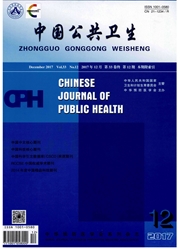

 中文摘要:
中文摘要:
目的了解中国2009-2014年疟疾疫情流行特征,为今后开展疟疾消除工作提供参考依据。方法收集2009年1月-2014年12月公共卫生科学数据中心(除港、澳、台地区)和全国疟疾疫情报告数据,应用Excel2010和SPSS19.0统计软件分析疟疾疫情的流行特征。结果中国2009-2014年共报告疟疾病例34843例,年均发病率为0.43/10万,其中2009、2010、2011、2012、2013、2014年疟疾发病率分别为1.06/10万、0.55/10万、0.30/10万、0.18/10万、0.29/10万、0.22/10万,疟疾发病率总体上呈下降趋势(z毛搏=3.012,P=0.003);疟疾多发于夏季,发病高峰为6—8月,3个月的疟疾发病例数占总发病例数的42.05%;报告疟疾总发病数居于前5位的地区分别为安徽(8868例,占25.45%)、云南(7546例,占21.66%)、河南(3390例,占9.73%)、江苏(1975例,占5.67%)和广西(1888例,占4.88%),5个地区的疟疾报告病例数占总报告病例数的67.92%;病例类型分为间日疟(20758例,占59.57%)、恶性疟(9769例,占28.04%)和未分型疟疾(4316例,占12.39%);2009--2014年本地感染病例所占比例逐年下降,从2009年的90.57%下降至2014年的1.92%,而境外输入病例所占比例逐年上升,从2009年的9.43%上升至2014年的98.08%。结论中国疟疾疫情有明显的季节性和地区特征,境外输入性疟疾已成为疟疾感染的主要来源。
 英文摘要:
英文摘要:
Objective To examine the situation of the malaria epidemics in China from 2009 to 2014 and to provide evidences for malaria elimination in China. Methods Data on malaria patients reported between January 2009 through September 2014 in China were collected from the Public Health Scientific Data Center ( excluding Hong Kong, Macao and Taiwan regions) and the National Malaria Epidemic Report System. Excel 2010 and SPSS 19. 0 were adopted in data analyses. Results A total of 34 843 malaria cases were reported during the period, with an average annual incidence rate of 0. 43/100 000. The incidence of malaria was generally decreased during the period (X^2 = 3. 012, P = 0. 003 ), with the annual incidence rate of 1.06,0. 55,0. 30,0. 18,0. 29, and 0. 22 per 100 000 population for the year of 2009,2010,2011, 2012,2013, and 2014, respectively. More malaria cases were reported in summer season, especially between June and Au- gust of a year, and 42. 05 % of the cases were reported during the 3-month period. The top 5 provinces with higher number of reported malaria cases were Anhui (8 868 cases,25.45 % of all cases reported), Yunnan (7 546,21.66 % ), Henan (3 390,9. 73% ) ,Jiangsu ( 1 975,5. 67% ) ,and Guangxi Zhuang Autonomous Region ( 1 888,4. 88% ) and the number of malaria cases reported in the 5 provinces accounted for 67.92% of all cases reported. Among the cases reported, the proportions of vivax,falciparum,and unclassified malaria were 59. 57% (20 758) ,28. 04% (9 769) ,and 12. 39% (4 316). The ratio of local malaria infection in China decreased from 90. 57% in 2009 to 1.92% in 2014,while the ratio of imported cases increased yearly from 9. 43% to 98. 08%. Conclusion The malaria epidemics in China has a distinct seasonal and regional distribution and the imported malaria has became the most important source of malaria infection in China.
 同期刊论文项目
同期刊论文项目
 同项目期刊论文
同项目期刊论文
 期刊信息
期刊信息
